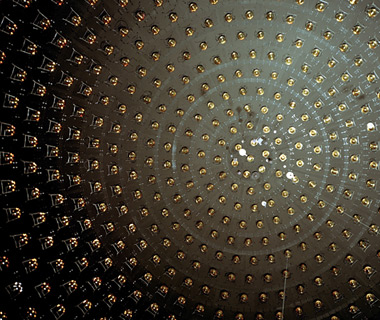 |
No-show neutrino, and a new mystery By David Harris The inside of the MiniBooNE tank is covered with 1280 inward-facing photomultiplier tubes. The picture shows a section of the upper hemisphere of the tank. Photo: Reidar Hahn, Fermilab |
The first results from the MiniBooNE neutrino experiment, released in April, showed no hints of a fourth neutrino. But they contained a puzzling signal that could lead to new physics.
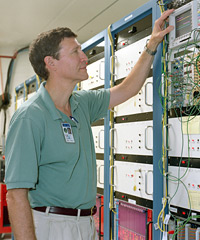 |
| MiniBooNE co-spokesperson Bill Louis, here checking the MiniBooNE data acquisition system, is a scientist at Los Alamos National Laboratory. In the 1990s, he worked on an earlier experiment that triggered the idea for the MiniBooNE experiment. Photo: Jenny Mullins, Fermilab |
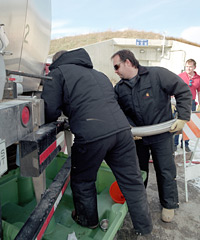 |
| Filling of oil into MiniBooNE Tank Photo: Reidar Hahn, Fermilab |
Heather Ray sat in a roomful of people and computers with her finger above a button. Her heart skipped a beat as she pressed it and initiated a chain of analysis. "It was the most nerve-wracking 90 minutes of my life," she says. At stake were the long-awaited results from an experiment designed to resolve a mystery that had puzzled physicists for more than a decade.
Fermilab's MiniBooNE experiment had been collecting data since 2002, looking for a particular kind of neutrino "oscillation" in which one type of neutrino changes into another. An earlier experiment had shown evidence for that type of oscillation, but it had not been observed elsewhere. If it were real, a huge change would be needed in how physicists think about the behavior of neutrinos and the foundations of particle physics.
After a wait that felt interminable, Ray, a scientist from Los Alamos National Laboratory (LANL), and the rest of the MiniBooNE collaboration saw a clear result: There was no evidence of the anomalous neutrino oscillation. And yet, there was something else in the data, a hint of a new mystery, in the form of extra low-energy electron neutrinos that had not been predicted or previously observed.
"More data is needed," says particle-physics theorist Boris Kayser of Fermilab, echoing the call of physicists since there have been physicists. Kayser, currently teaching at Columbia University, is not connected with the MiniBooNE results except through his own 30 years of neutrino ponderings. "The question," he continues, "considering what MiniBooNE has reported, is this: What do we do now?"
Columbia University's Janet Conrad, one of two spokespeople for MiniBooNE, emphasizes "This is only our first step."
The other, Bill Louis of LANL, says, "I've spent the last 18 years investigating neutrino oscillations, and it keeps getting more and more interesting. As in many particle physics experiments, we have a result that answers some questions and raises others."
Ubiquity
Neutrinos are everywhere. There are billions of them passing through everyone on Earth all the time, unnoticed because they rarely interact with other forms of matter. Even so, they play a role in some of the most significant physical processes in the universe, such as the nuclear reactions that make the Sun shine.
"Even though they interact so weakly, neutrinos represent one of the dominant particles in the universe, along with photons," says Louis. "There are somewhere on the order of a billion times as many neutrinos as there are protons in the universe. They have played a crucial role in the evolution of the universe." In fact, he says, "We can almost regard neutrinos as the particles that tell us how much we don't know about the universe."
The particle wasn't even theorized until 1930, when physicist Wolfgang Pauli found that some of the energy expected from the decay of an atomic nucleus was missing. Pauli proposed a new particle as the famous "desperate remedy" to save the law of conservation of energy. He described the particle, which he thought might never be detected, in his letter to "Dear Radioactive Colleagues" at an upcoming conference in Tubingen, Germany. (See symmetry, Mar 2007).
Pauli was not completely correct: The particle was detected, although it took more than 25 years. The first observation of the neutrino was confirmed in 1956 by Frederick Reines and Clyde Cowan with a detector at the Savannah River nuclear reactor. Since then, physicists have confirmed the existence of three types of neutrinosthe electron neutrino, muon neutrino, and tau neutrinoand have learned a lot about how they change from one species to the next.
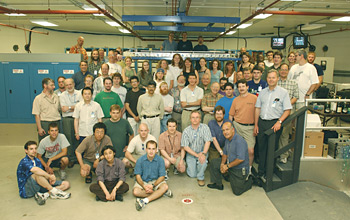 |
| MiniBooNE Collaboration Photo: Reidar Hahn, Fermilab |
A challenge to past results
During the 1990s, the Liquid Scintillator Neutrino Detector (LSND) experiment at Los Alamos National Laboratory showed evidence for a new type of neutrino oscillation. That oscillation would have implied the existence of a fourth species of neutrino, a surprising addition to the standard picture of three neutrinos. The LSND result suggested that muon neutrinos could first turn into a fourth species of "sterile" neutrinos before turning into electron neutrinos.
"Two kinds of oscillations could be explained with three neutrinos, but three kinds could not," says Louis, who was involved with LSND beginning with its design in 1989. "Our result was viewed skeptically, and that's a strength of our field. People have to be convinced. Because of the far-reaching consequences of this interpretation, the LSND findings cried out for independent verification."
MiniBooNE was designed (and approved as an experiment in 1998) specifically to confirm or refute this puzzling claim of a possible fourth neutrino.
The experiment's first scientific results, announced at Fermilab on April 11, 2007, found no evidence for the extra type of oscillation, confirming the picture of three types of neutrino laid out in the Standard Model of fundamental particles and forces, the foundation of particle physics for more than 30 years. Although it didn't completely rule out the earlier observation, MiniBooNE did show that there is no way to explain it using only simple back-and-forth oscillations between pairs of neutrino species. If the LSND result is correct, there must be some new physics at play.
Easy as pion
MiniBooNE sends a beam of pure muon neutrinos toward a detector. Some of the muon neutrinos turn into electron neutrinos during their journey and the detector counts how many electron neutrinos appear. The number of electron neutrinos provides information about the types of oscillations that occurred along the way.
Creating neutrinos in the large quantities needed is not easy and takes multiple steps. First a proton beam from Fermilab's Booster accelerator hits a beryllium target. The proton bombardment creates many debris particles, some of which are short-lived pions, or pi mesons.
An intense focusing magnet called the horn sends the pions down a 50-meter pipe. As they travel, the pions decay into muon neutrinos, which then pass unimpeded through 440 meters of rock beneath the Fermilab site to the detector, a 12-meter-diameter spherical steel tank filled with 250,000 gallonsmore than 800 tonsof ultra-pure mineral oil, and lined on the inside with 1520 photomultiplier tubes.
MiniBooNE detected just the number of electron neutrinos predicted by simple muon- to electron-neutrino oscillation with no need for a fourth neutrino species. Many physicists find this is strong evidence that there is no fourth neutrino at all, but others point out that it is possible that more exotic physics could explain the LSND result. In fact, MiniBooNE did see an apparent excess of neutrinos with lower energies, an intriguing invitation for more analysis.
There are still loopholes in the results. MiniBooNE's experiment used a beam of neutrinos, while LSND used antineutrinos. "There is the possibility that neutrinos and antineutrinos oscillate differently," says Kayser.
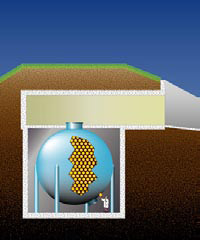 |
| The MiniBooNE detector is a 250,000-gallon tank filled with mineral oil, which is clearer than water from a faucet. Light-sensitive devices inside the tank detect collisions between neutrinos and the nuclei of carbon atoms within the oil molecules. Illustration: Reidar Hahn, Fermilab |
As a further test of the LSND result, which will also explicitly probe similarities between neutrinos and antineutrinos, MiniBooNE started operating with an antineutrino beam in January 2006. Experiments around the world have been amassing data on the subtle but distinct differences in behavior between various particles of matter and antimatter. This phenomenon, called CP violation, is increasingly regarded as the solution to the mystery of the matter-antimatter imbalance in the formation of the universe, which ultimately enabled life as we know it. Seeing CP violation for neutrinos, says Kayser, "would be extremely interesting."
In the balance
"One possibility in the matter-antimatter imbalance involves CP violation in the early universe with heavy neutrinos that are not with us anymore," Kayser says. "If that had been the case, we would like to see related CP violation in light-neutrino oscillation today."
For Louis and the 77-member MiniBooNE collaboration, and for Kayser and the community of neutrino researchers standing by, the next critical goal is to understand what MiniBooNE's unusual low-energy signal represents.
"Is it a signal, or is it background?" says Louis. "Either way, it's very important to know for the future. It could indicate CP violation, or extra dimensions, or other violations. There is a whole slew of possibilities."
"In the 50 years since its discovery," he adds, "the neutrino has continued to surprise us. I wouldn't be surprised if the neutrino has more surprises in store."
Click here to download the pdf version of this article.






